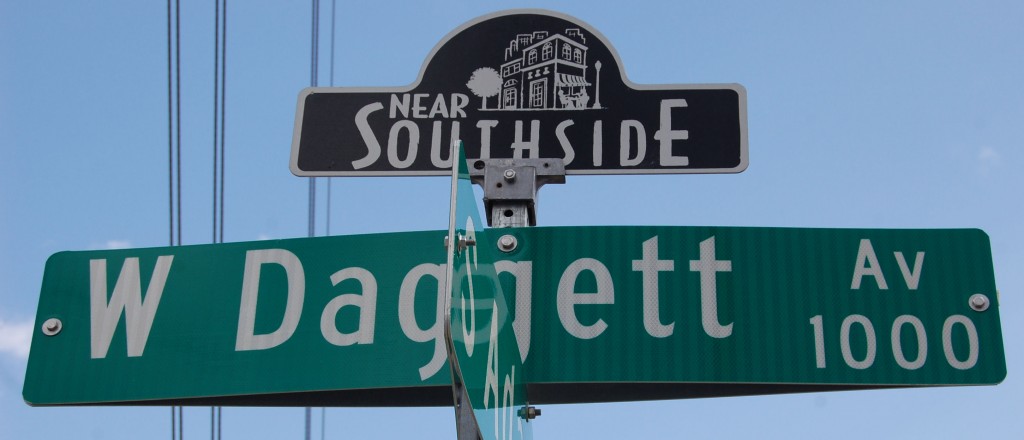
He was a member of an elite group: the Fort Worth street gang—those pioneers who have a street named after them.
He would not become a resident of Fort Worth until he was forty-four years old—middle age for a man of his time. But he did so much for Fort Worth that newspaper editor B. B. Paddock, in his multivolume history of Fort Worth, called Ephraim Merrell Daggett “the father of Fort Worth.”
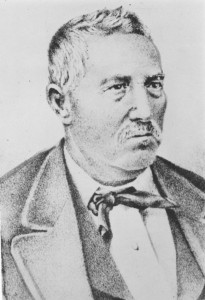
Daggett was born on June 3, 1810. Still living on that date were Jefferson, Napoleon, and Beethoven.
Daggett was born in Canada eight miles from Niagara Falls, moved to Indiana in 1820, traded with Native Americans at Fort Dearborn (Chicago) in 1833, moved to Shelby County, Texas, in 1840 for his health (he suffered from rheumatism). When two feuding factions in Shelby County clashed in the Regulator-Moderator War (or “Shelby County War”) in 1842-1844 over land swindling, fraud, and cattle rustling in east Texas, Daggett was a Regulator. (Shelby County also sent us Middleton Tate Johnson and Captain Charles Turner.) In the Mexican-American War of 1846-1848 Daggett fought under Texas Ranger Captain John Coffee Hays. During the Battle of Monterrey in 1846 Daggett, along with Ripley Arnold, fought under the command of General William Jenkins Worth.
 The Texas State Gazette clip above shows that by 1851 Daggett was back in Shelby County, where he was being “spoken of” as a candidate for the House of Representatives.
The Texas State Gazette clip above shows that by 1851 Daggett was back in Shelby County, where he was being “spoken of” as a candidate for the House of Representatives.
Daggett had visited the Army’s Fort Worth after its establishment in 1849. He began to buy land here while he still lived in Shelby County. But in 1854 the peripatetic Daggett moved to Fort Worth with his family and slaves, five years after his brother, Henry Clay Daggett, and Archibald Franklin Leonard had opened the first business in Fort Worth.
In the fort-turned-village E. M. Daggett put down roots—roots that grew ever deeper as the village grew into a town, the town into a city. In 1853, near the intersection of today’s Bluff and Houston streets, Daggett converted the abandoned fort’s stable into the nascent town’s first hostelry, complete with dirt floor.
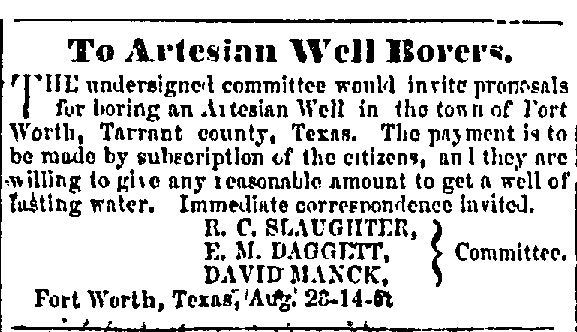
In 1856, this Dallas Herald clips shows, Daggett was part of a group trying to procure fresh drinking water for the new town.
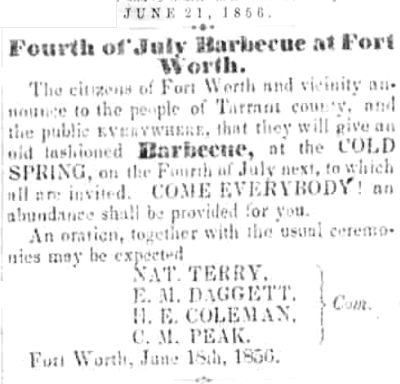
Also in 1856 Daggett helped organize the annual Fourth of July celebration at the Cold Springs east of Samuels Avenue.
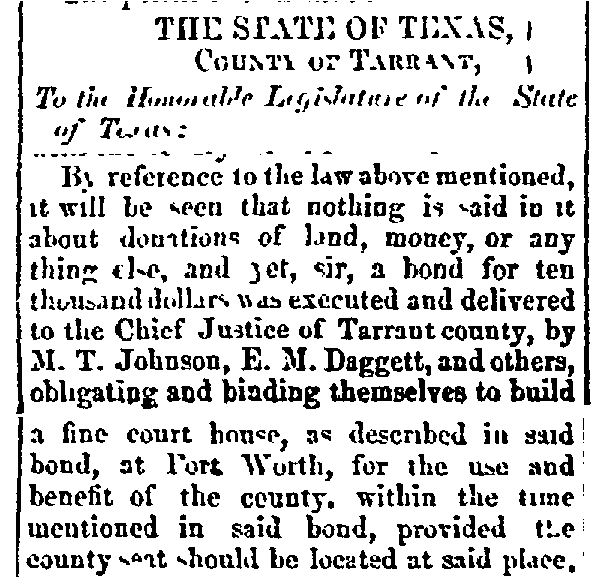
Daggett used his influence as a former state legislator to help secure Fort Worth’s selection as county seat in 1856. This 1858 Texas State Gazette clip shows that Daggett was among city leaders working to get the town’s first courthouse built. These civic leaders promised the state that if the county seat were moved to Fort Worth from Birdville, the citizens of Fort Worth would build a new courthouse at no expense to the county.
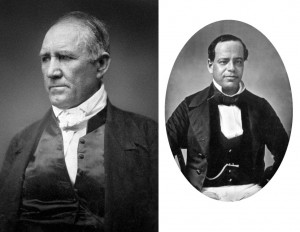
In 1857 Sam Houston was in town campaigning for governor. He spent the night with the Daggetts, who lived on a plantation whose house was located near where the convention center is today. The leg wound that Houston had received at the Battle of San Jacinto in 1836 had never healed and bothered him that night. Daggett washed and dressed Houston’s wound, using the silver wash basin of Houston’s old adversary of 1836: General Santa Anna. Daggett had confiscated the wash basin while chasing Santa Anna after the Battle of Buena Vista in the Mexican-American War.
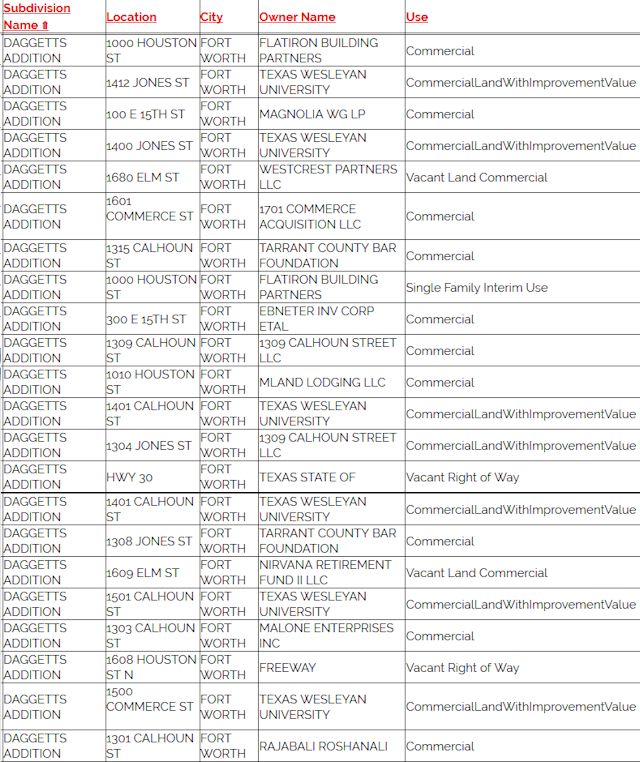 Daggett’s plantation covered much of what would become south downtown.
Daggett’s plantation covered much of what would become south downtown.
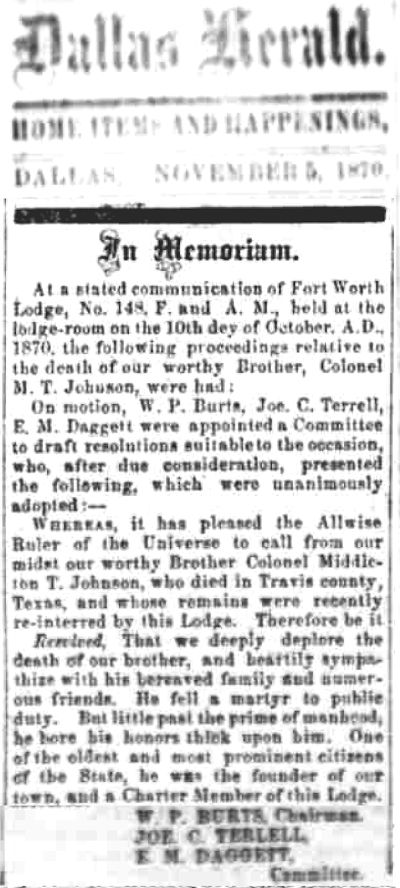 In 1870, when Masons of Middleton Tate Johnson’s Fort Worth lodge moved his body from the state cemetery to the Johnson family cemetery in Arlington, Daggett was on the committee, along with William Paxton Burts and Joseph Christopher Terrell, that drafted a resolution honoring Johnson. Daggett had been a member of Fort Worth’s first Masonic lodge when it was chartered in 1855.
In 1870, when Masons of Middleton Tate Johnson’s Fort Worth lodge moved his body from the state cemetery to the Johnson family cemetery in Arlington, Daggett was on the committee, along with William Paxton Burts and Joseph Christopher Terrell, that drafted a resolution honoring Johnson. Daggett had been a member of Fort Worth’s first Masonic lodge when it was chartered in 1855.
Daggett also was instrumental in luring the Texas & Pacific Railroad to Fort Worth in 1876, donating ninety-six acres south of town for the T&P station and track. So civic-minded was this Canadian in his adopted city that when Fort Worth incorporated in 1873, the city council voted to have Daggett’s likeness placed on the city seal. Cowtown pioneer Joseph Christopher Terrell described Daggett as “grand” physically (275 pounds), morally, and mentally. Historian Julia Kathryn Garrett wrote that a Native American, when introduced to Daggett, said of him: “Too big for a man, not big enough for a horse.”
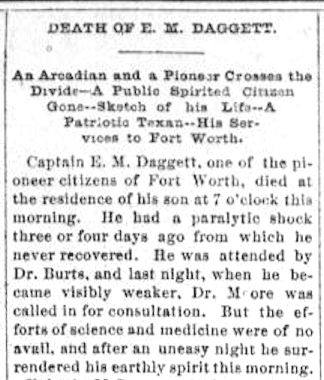
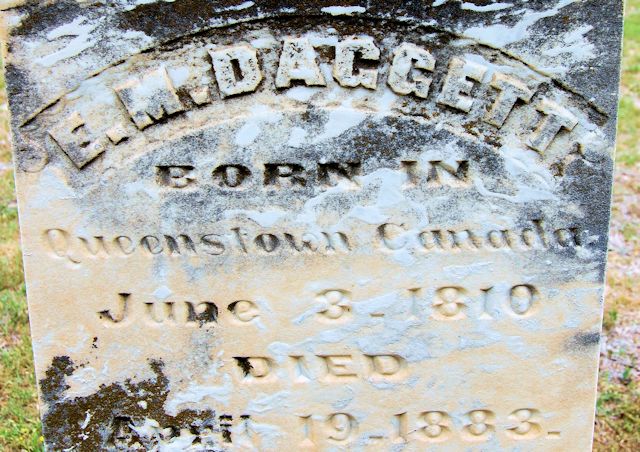 Ephraim Merrell Daggett died in 1883. He was attended by Fort Worth’s first mayor, Dr. William Paxton Burts. Clip is from the April 19 Gazette.
Ephraim Merrell Daggett died in 1883. He was attended by Fort Worth’s first mayor, Dr. William Paxton Burts. Clip is from the April 19 Gazette.
Ephraim Merrell Daggett is buried, fittingly, in Pioneers Rest Cemetery.






Smith owned 1,000 acres of land in Tarrant County in 1865 and quickly rose to prominence in Fort Worth society. Within five years he had doubled his holdings, and by the early 1880s he had amassed city lots valued at more than $50,000 and thousands of acres of land. He was reported to be the largest landowner in Fort Worth. Smith donated much of his time and land to the development and expansion of Fort Worth. He successfully battled to have the county seat moved to his city from Birdville. As a private citizen he was instrumental in many new business ventures. He was a partner in the Fort Worth Street Railway Company, thus establishing the first public inner city transportation system. Additionally, he helped promote the first railroad into Fort Worth-the Texas and Pacific-and donated thousands of dollars to railroad expansion. In 1891 Smith was a key figure in the building of the first stockyard in Fort Worth. Nearly all of the larger cattle companies of northwest Texas were obliged to Smith for their organization, and many young cattlemen were personally indebted to him for his assistance.
Smith was elected mayor of Fort Worth in 1882 and served the first of six terms. Under his guidance, several public services were initiated, including the city’s first water department. As a public official he helped establish an independent school system and also served as a trustee on the first school board. In addition to his other accomplishments, Smith was the president of the Fort Worth Gas Light and Coal Company.
I just donated many papers and documents about the Jo Glazer
family of Fort Worth to UNT ARCHIVE DEPARTMENT
One of these was a deed/ sale recorded in 1892 where E.M. DAGGETT was one of the sellers. It seems to record property
that eventually became THE UNCLE JO BOTTLING WORKS
Is there a procedure to trace the property owners from 1892
till approximately 1915?
Thanks
Morton Glazer
[email protected]
Morton, E. M. Daggett was dead by 1882 but could well have owned that land. He and later Daggetts owned land west and south of the Uncle Jo site. That Uncle Jo site could have been owned by E. M. (Bud) Daggett, a nephew of the first E. M. I know of no way to trace a chain of ownership of land going back that far short of in-person research of county records.
I have a question. On Sept 13th of 1860, Reverend Anthony Bewley was hanged. It is said that his bones were placed on “Daggett Storehouse.” Do you know where his storehouse would have been located? Do you know his relation to this incident?
Alex, I have a separate post that touches on the Bewley hanging. I assume that his “storehouse” was his dry goods store on the square.
Thank you so much. I’m just about to the 1850s in my research of my African-American Daggett ancestors from Fort Worth, Texas.
You are welcome, Karen. In case you have not seen it, I have a post on Jeff Daggett.
Can you tell me where to find E.M. Daggett’s register of slaves?
Sorry, Karen. I find his 1850 census entry but no slave schedule in either Shelby County or Tarrant County.
My children are decedents of EM Daggett and live in Decatur, Tx. They have recently inherited a large framed portrait of EM Daggett that has hung in their grandmother’s home for years.
1. I would like information on a prominent place in Ft Worth that might like to display his portrait and his history if my children decide to loan it out for display.
2. I would love to have a copy of EM’s family tree to date, if possible. Any idea who might have such research completed?
Thank you!
I forwarded your message to Dawn Youngblood at Tarrant County Archives and to Melanie Smith, a Daggett descendant working on a marker for Daggett’s Crossing, but their e-mail to you and mine to you bounced back as suspected spam. Reply to this comment, and we will work out some way to communicate. I have e-mail addresses or phone numbers.
EM is my ancestor. He married a Ferguson. My Great Great Uncle was his Father in law.
Could you tell me how to access the Daggett genealogy? My uncles grandmother was a Daggett. And we would like to connect with any living descents of Ephraim Merrell Daggett.
Katta:
I have given your e-mail address to a Daggett descendant/researcher who might be able to help. Good luck.
Name: Pheroba Strouse
Gender: Female
Event Type: Marriage Registration (Marriage)
Marriage Licence Date: 2 Jan 1836
Marriage Licence Place: Indiana, United States
Spouse: Ephraim M Daggett
Officiator: John G Davis
Page: 31
FHL Film Number: 002209418
They must have divorced because Pheroba Strouse married Name: Phereby Daggett
Spouse: John Goodrich
Marriage Date: 25 Jul 1841
Marriage County: Cass
She was 14 or 15 years old when she married Daggett if the 1860 Census is correct on her age. She had two sons by Goodrich, one son Justice/Justus Goodrich oddly enough lived briefly in Fort Worth in the 1890’s. There is no documentation Pheroba/Pheroby, etc was a daughter of Hayes. Copies of the marriage records are available on Ancestry and Family Search.org. If we are referring to “Jack” Coffee Hayes, his lineage has pretty much been documented and verified, though he had daughters, there is no daughter by such name.
Thanks, Donna. That father-daughter claim is from Garrett’s history and also a Daggett family genealogy site (which may be merely repeating Garrett’s claim). I have made the correction.
I am a great, great, great granddaughter of Charles Biggers Daggett, and I also live in Fort Worth. I have hired a professional Historian to help research and authenticate the site of C. B. Daggett and Sons Ferry and Trinity River Crossing which is close to his homestead (where Mt.Olivet Cemetery is today). I would appreciate any information anyone has that can help authenticate that site. When approved by the Texas Historical Commission, I will plan an installation ceremony, and I hope all of you who are interested will participate. Also, I am confused about the correct identity of E. M. Daggett’s first wife. I know Rick Selcer and others have asserted that she was Col. Jack Hays’ daughter, but I also see that the Salt Lake City Library shows an Ephraim Daggett married a Pheroba Strouse on Dec 15, 1835 in Parke County, Indiana.
I hope your research on the location of the crossing is successful. So many geographical sites like the crossing—and the Cold Springs-were not precisely located in descriptions of the time. No need to: Everyone knew where everything was. And the course of the river in that area has changed so much since then. I wonder if Daggett’s crossing is the crossing that trail drivers used, said to be south of Trail Drivers Park, which is west of the C. B. homestead.
I have read in more than one source that E. M. married Pheneba, daughter of Jack Hays. Here is a genealogical site.
Don’t see much on E M Daggett’s brothers Charles or Henry Clay, it was my understanding one of them worked with Ripley Arnold in setting up Camp Worth where it was situated. Thanks
John, Charles and Henry Clay certainly don’t get as much “press” as Eph. I mention Charles in connection with his homestead where Mount Olivet would be and his crossing on the river. I mention Henry Clay in connection with scouting the site of the fort and his trading post with Archibald Leonard. The blog is searchable by words such as “Henry Clay” and “Charles Biggers.”
Mike,
Ihave seen some people have said EM Daggett was married to someone relayed to Colonel John Coffee Hays, they claim headstone mentions spouse #1 as M Hays, but can find no proof of this. Can you advise on this. Thanks
John, from my post on Jeff Daggett: Ephraim and his first wife Pheneba (daughter of Texas Rangers Colonel Jack Hays) had one son, born in 1838: Ephraim Beck Daggett. Pheneba died in childbirth, and Ephraim married Caroline Nored.
(I have also seen Pheneba referred to as “Faribo.”)
He was my Great Great, Grandfather, my mother Elizabeth Ray Daggett, her father was Raymond Daggett. We are still here in Fort Worth, but dying off. My brother had a daughter, but I have no children,,, at 71 years.
Jay, I am also a descendant of EM Daggett. I live in WIsconsin, but one of my children is living in Dallas. We may be visiting Fort Worth at the end of May.
As I have read accounts of Daggett’s Plantation and the visit by Sam Houston, I realize that our Houston Street is not just named after a founding Texan as any other city in Texas may have done (and many have). Our Houston Street means a bit more to me knowing that it was more likely named in honor of his 1857 visit to Fort Worth. I hope I am right about this.
How I wish I could come upon some documentation of how and when streets got their names. In the case of the original town site downtown, the streets were named before we had newspapers or city council meetings. Beyond those original streets, I have been hesitant to assume for whom streets are named except in cases of unusual names (McCart, Daggett, Peter Smith, Jarvis, Vickery, etc.).